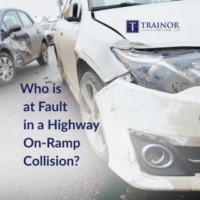Who is at Fault in a Highway On-Ramp Collision?

Highway on-ramps are statistically prone to accidents, particularly merging accidents, which often involve vehicles moving at different speeds. These collisions can result in serious injuries and complex legal disputes over liability. In merging accidents, liability is typically determined by assessing which driver acted irresponsibly or violated traffic laws, such as failing to yield the right-of-way to existing traffic. The factors that contribute to these incidents are essential for navigating the legal process and ensuring fair compensation for injuries and damages, which involves understanding car accident claims.
Louisiana Traffic Laws and Right-of-Way
Louisiana’s legal framework plays a vital role in determining fault in on-ramp collisions. The state’s traffic laws clearly define the responsibilities of both merging drivers and those already on the highway. These laws are the first step in assessing liability.
The Duty to Yield (Merging Drivers)
Louisiana Revised Statute 32:124 establishes that drivers entering or crossing a highway from private roads, driveways, alleys, or buildings must yield the right-of-way to vehicles already traveling on the highway if those vehicles are close enough to pose an immediate hazard. While the statute does not specifically mention on-ramps, Louisiana law generally requires drivers merging onto a highway from an on-ramp to yield to vehicles already traveling on the main highway.
This “duty to yield” places the primary responsibility on the merging driver to ensure a safe entry. This means:
- Assessing Traffic: The merging driver must carefully observe the speed and position of highway traffic.
- Finding a Safe Gap: The driver must identify a sufficient gap in traffic to merge without disrupting the flow or causing other drivers to brake suddenly.
- Using the Acceleration Lane: The acceleration lane is provided specifically for this purpose – to allow merging vehicles to reach a speed compatible with highway traffic before entering the main lanes.
- Signaling Intentions: Using turn signals well in advance is mandatory, alerting other drivers to the intended maneuver.
Responsibilities of Highway Drivers
While merging drivers bear the primary responsibility for yielding, drivers already on the highway in Louisiana are not entirely absolved of responsibility. They have a duty to:
- Maintain a Safe Following Distance: This allows for reaction time and provides space for merging vehicles.
- Be Aware of Merging Traffic: Drivers should be attentive to on-ramps and anticipate potential merges.
- Adjust Speed or Lane Position (If Safe): While not legally required to change lanes or slow down for every merging vehicle, a highway driver should do so if it can be done safely and helps avoid a collision. This demonstrates a “duty of care.”
- Avoid Aggressive Actions: Sudden braking, acceleration or weaving can increase the risk of on-ramp collisions.
Louisiana’s Comparative Fault Law (Civil Code Article 2323)
Louisiana Civil Code Article 2323 establishes the state’s “pure comparative fault” system. This is critical to understanding how fault is assigned in accidents. It means that even if you are partially responsible for an on-ramp collision, you may still be able to recover some damages. The amount you can recover is reduced by your percentage of fault.
Common Causes of On-Ramp Collisions
The common causes of these accidents is essential for both prevention and for determining fault after a collision has occurred.
Driver Error (Merging Driver)
- Failure to Yield: The most frequent cause, stemming from misjudging the speed of highway traffic or simply failing to look properly.
- Improper Speed Adjustment: Merging too slowly or too quickly can create dangerous situations.
- Distracted Driving: Cell phone use, adjusting the radio, or other distractions can lead to a failure to properly assess the merging situation.
- Driving Under the Influence (DUI): Alcohol or drugs impair judgment and reaction time, making safe merging impossible.
- Improper Use of Mirrors: Failing to check all mirrors, creating a dangerous situation.
Highway Driver Negligence
- Speeding: Excessive speed reduces a highway driver’s ability to react to merging vehicles.
- Failure to Maintain Safe Distance: Tailgating leaves no room for error if a merging vehicle needs to slow down.
- Aggressive Driving: Weaving, cutting off vehicles, and other aggressive behaviors increase the risk of collisions.
- Distracted Driving: Similar to merging drivers, distracted highway drivers are less likely to see and react to merging vehicles.
- Improper Lane Changes: Abrupt lane changes near an on-ramp can be extremely dangerous.
Environmental and Infrastructure Factors
- Poor Visibility: Rain, fog, darkness, or glare can make it difficult to see merging vehicles or judge distances.
- Adverse Weather Conditions: Wet or icy roads reduce traction and increase stopping distances.
- Defective On-Ramp Design: Short acceleration lanes, poor sightlines, or inadequate signage can contribute to accidents. While this is less common, it can be a factor in assigning fault.
- Road Debris: Objects or debris on the on-ramp or the highway can create an unforeseen hazard.
Determining Fault: The Role of Evidence
After an on-ramp collision in Louisiana, gathering evidence is necessary for establishing fault. Several types of evidence can be used to reconstruct the events and determine liability.
Police Reports
The official police report is a critical piece of evidence. It will typically include:
- A description of the accident scene.
- Statements from the drivers involved.
- Statements from any witnesses.
- Diagrams of the accident.
- The officer’s assessment of contributing factors (though this is not legally binding).
- Any citations issued.
It’s essential to obtain a copy of the police report as soon as possible. If you believe the report contains errors, you can attempt to have it amended, but this can be challenging.
Witness Statements
Independent witness statements can be invaluable. Witnesses who saw the accident unfold can provide unbiased accounts that corroborate or contradict the drivers’ versions of events.
Vehicle Damage and Accident Reconstruction
The physical damage to the vehicles involved can tell a story. Experts in accident reconstruction can analyze:
- Points of impact.
- Crush patterns.
- Tire marks (skid marks, yaw marks).
- Debris fields.
This analysis can help determine the speed and direction of the vehicles at the time of impact, and potentially identify who was at fault.
Video and Photographic Evidence
- Dashcam Footage: If either driver had a dashcam, the footage can provide a clear record of the accident.
- Traffic Cameras: In some cases, traffic cameras may have captured the collision.
- Photos of the Scene: Photos taken immediately after the accident (if it’s safe to do so) can document the position of the vehicles, road conditions, and any visible damage.
Medical Records
Medical records are crucial for documenting the extent of any injuries sustained in the accident. They can also, in some cases, provide indirect evidence about the forces involved in the collision, which can be relevant to determining fault.
Comparative Fault in Louisiana (Detailed Explanation)
As mentioned earlier, Louisiana operates under a pure comparative fault system. This means that fault is not an all-or-nothing proposition. It’s possible (and often the case) that both drivers involved in an on-ramp collision share some degree of responsibility.
Apportioning Fault
The percentage of fault assigned to each driver is determined by the evidence and the applicable laws. This can be done through negotiation between insurance companies or, if a lawsuit is filed, by a judge or jury.
Examples of Shared Fault
- Example 1: A merging driver fails to yield, but the highway driver was speeding. The merging driver might be found 70% at fault, and the highway driver 30% at fault.
- Example 2: A highway driver makes an unsafe lane change, but the merging driver was distracted by their phone. The highway driver might be found 60% at fault, and the merging driver 40% at fault.
- Example 3: A merging driver enters the highway at an extremely slow speed, while the highway driver fails to maintain a safe following distance. Both drivers might be found 50% at fault.
Impact on Damages
Your percentage of fault directly affects the amount of damages you can recover. If your total damages (medical bills, lost wages, pain and suffering, etc.) are $50,000, and you are found to be 25% at fault, you can only recover $37,500 (75% of the total).
Legal Considerations and Insurance Claims in Louisiana
After an on-ramp collision in Louisiana, understanding the legal and insurance processes is vital.
Filing Insurance Claims
You will typically file a claim with your own insurance company and potentially with the other driver’s insurance company. Providing accurate information and evidence is crucial. Be prepared for the insurance company to investigate the accident and assign fault.
Potential for Personal Injury Lawsuits
If you are injured and believe the other driver was primarily at fault, you may have grounds for a personal injury lawsuit. This allows you to seek compensation for your damages.
Seeking Legal Counsel
It’s highly recommended to consult with an experienced Louisiana car accident attorney, especially if:
- You have suffered significant injuries.
- Fault is disputed.
- The insurance company is denying your claim or offering an unfair settlement.
- You are unsure of your legal rights.
An attorney can protect your interests and guide you through the complex legal process.
Statute of Limitations in Louisiana
Louisiana has a one-year statute of limitations for personal injury claims arising from car accidents (Louisiana Civil Code Article 3492). This means you have one year from the date of the accident to file a lawsuit. Missing this deadline means you lose your right to sue.
Prevention and Safety Tips
Preventing on-ramp collisions is always the best approach. Here are some tips for both merging and highway drivers:
Tips for Merging Drivers
- Use the Entire Acceleration Lane: Don’t try to merge prematurely.
- Match the Speed of Traffic: Get up to highway speed before merging.
- Signal Early and Clearly: Let other drivers know your intentions.
- Check Blind Spots Carefully: Use your mirrors and look over your shoulder.
- Be Patient: Wait for a safe gap in traffic.
- Don’t Force Your Way In: If there’s no safe gap, slow down or even stop at the end of the ramp (if necessary) and wait for an opening.
Tips for Highway Drivers
- Be Alert to Merging Traffic: Pay attention to on-ramps.
- Maintain a Safe Following Distance: This gives you time to react.
- Move Over If Possible: If it’s safe, move to the left lane to create space for merging vehicles.
- Avoid Distractions: Put away your phone and focus on driving.
- Don’t Speed: Obey the posted speed limit.
Navigating the Aftermath of an On-Ramp Collision in Louisiana – Your Next Steps with Trainor Law Firm
Highway on-ramp collisions in Louisiana present unique challenges, blending the complexities of merging traffic with the state’s specific comparative fault laws. At Trainor Law Firm, we understand the intricacies of Louisiana car accident law, including the nuances of on-ramp collisions. Our experienced team has a proven track record of helping clients throughout Louisiana understand their rights, gather the necessary evidence, and build strong cases. We’re committed to providing compassionate guidance and aggressive representation to ensure you receive fair compensation for your injuries and losses.
If you or a loved one has been involved in a highway on-ramp collision in Louisiana, we encourage you to reach out for a free, no-obligation consultation. Contact us today, and let us help you seek the justice and compensation you deserve.



